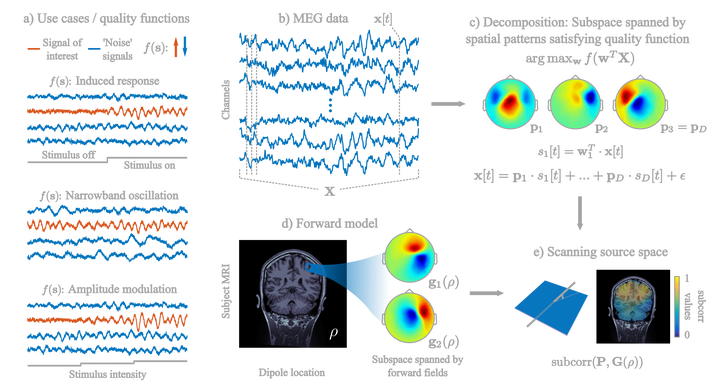Imaging of neural oscillations with embedded inferential and group prevalence statistics

Abstract
Magnetoencephalography and electroencephalography (MEG, EEG) are essential techniques for studying distributed signal dynamics in the human brain. In particular, the functional role of neural oscillations remains to be clarified. For that reason, imaging methods need to identify distinct brain regions that concurrently generate oscillatory activity, with adequate separation in space and time. Yet, spatial smearing and inhomogeneous signal-to-noise are challenging factors to source reconstruction from external sensor data. The detection of weak sources in the presence of stronger regional activity nearby is a typical complication of MEG/EEG source imaging. We propose a novel, hypothesis-driven source reconstruction approach to address these methodological challenges. The imaging with embedded statistics (iES) method is a subspace scanning technique that constrains the mapping problem to the actual experimental design. A major benefit is that, regardless of signal strength, the contributions from all oscillatory sources, which activity is consistent with the tested hypothesis, are equalized in the statistical maps produced. We present extensive evaluations of iES on group MEG data, for mapping 1) induced oscillations using experimental contrasts, 2) ongoing narrow-band oscillations in the resting-state, 3) co-modulation of brain-wide oscillatory power with a seed region, and 4) co-modulation of oscillatory power with peripheral signals (pupil dilation). Along the way, we demonstrate several advantages of iES over standard source imaging approaches. These include the detection of oscillatory coupling without rejection of zero-phase coupling, and detection of ongoing oscillations in deeper brain regions, where signal-to-noise conditions are unfavorable. We also show that iES provides a separate evaluation of oscillatory synchronization and desynchronization in experimental contrasts, which has important statistical advantages. The flexibility of iES allows it to be adjusted to many experimental questions in systems neuroscience.